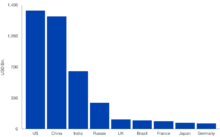Military budget
A military budget (or military expenditure), also known as a defense budget, is the amount of financial resources dedicated by a nation to raising and maintaining an armed forces or other methods essential for defense purposes.
Military budgets often reflect how strongly an entity perceives the likelihood of threats against it, or the amount of aggression it wishes to employ. It also gives an idea of how much financing should be provided for the upcoming year. The size of a budget also reflects the entity's ability to fund military activities.[1] Factors include the size of that entity's economy, other financial demands on that entity, and the willingness of that entity's government or people to fund such military activity. Generally excluded from military expenditures is spending on internal law enforcement and disabled veteran rehabilitation. The effects of military expenditure on a nation's economy and society, and what determines military expenditure, are notable issues in political science and economics. There are controversial findings and theories regarding these topics. Generally, some suggest military expenditure is a boost to local economies.[2] Still, others maintain military expenditure is a drag on development.[3]
Every year in April is the Global Day of Action on Military Spending (GDAMS), which aims to gather people and create a global movement that persuades governments to reallocate their military spending to essential human needs such as food, education, health care, social services and environmental concerns.[4]
Among the countries maintaining some of the world's largest military budgets, China, France, Germany, Japan, Russia, the United Kingdom and the United States are frequently recognized to be great powers.[5]
According to the Stockholm International Peace Research Institute, in 2014, total world military expenditure amounted to 1.8 trillion US$.[6]
Historic expenditure
The Saturday Review magazine in February 1898 outlined the levels of military expenditure as a percentage of tax revenue spent by the then great powers for the year 1897:[7]
- United States: 17%
- Russian Empire: 21%
- France: 27%
- British Empire: 39%
- German Empire: 43%
- Empire of Japan: 55%
Projected expenditure
A 2014 academic report from the United Kingdom's Ministry of Defence outlines projected defence expenditure of major powers for the year 2045.[8]

| Rank | Country | Spending in PPP ($ Bn.) |
|---|---|---|
| 1 | | 1,335 |
| 2 | | 1,270 |
| 3 | | 654 |
| 4 | | 295 |
| 5 | | 108 |
| 6 | | 89 |
| 7 | | 87 |
| 8 | | 67 |
| 9 | | 63 |
See also
- List of countries by military expenditures
- List of countries by past military expenditure
- List of countries by military expenditure per capita
- Permanent war economy
- History of military technology
- Military Keynesianism
- Military-industrial complex
- Peace dividend
- Defense contractor
- Guns versus butter model
- Swords to ploughshares
- List of countries by Global Militarization Index
References
- ↑ Statistics on Defense Expenditures in the U.S. per Capita, 1990-2011, NATO, April 2012.
- ↑ Hicks, Louis; Curt Raney (2003). "The Social Impact of Military Growth in St. Mary's County, Maryland, 1940-1995". Armed Forces & Society. 29 (3): 353–371. doi:10.1177/0095327x0302900303.
- ↑ Nef, J.U. (1950). War and Human Progress. Cambridge: Harvard University Press.
- ↑ GDAMS
- ↑ Baron, Joshua (22 January 2014). Great Power Peace and American Primacy: The Origins and Future of a New International Order. United States: Palgrave Macmillan. ISBN 1137299487.
- ↑ "US military spending falls, increases in eastern Europe, Middle East, Africa and Asia". www.sipri.org. SIPRI. Retrieved 17 April 2015.
- ↑ Frank Harris (editor) (February 1898). Saturday Review Magazine.
- 1 2 Global Strategic Trends out to 2045, gov.uk, 15 July 2014
- Hicks, Louis; Raney, Curt. "The Social Impact of Military Growth in St. Mary's County, Maryland, 1940-1995". Armed Forces & Society. 29: 3.